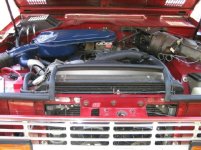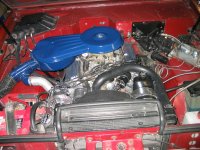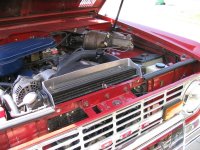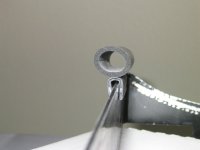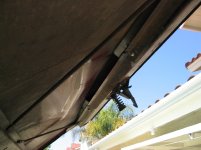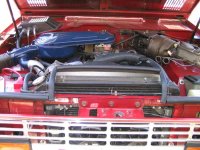Pressure has the same effect, regardless what caused the pressure.
Correct, but a limited answer
Both may do the same thing in a static and evenly shaped environment with even temperatures, but not inside an engine where increased flow has it's effect added to the increased flow pressure.
Pressure due to flow is no different from pressure due to thermal expansion of a gas, or pressure due to depth of liquid, or pressure due to mechanical compression.
Wrong again.
Inside a proper cooling system at least, pressure due to flow is perhaps double the pressure from ambient temperature inside the system.
Maybe they are the same when you're talking about numbers on a scale (after all, a psi is a pound per square inch no matter how you spell it), but not the same when talking about what they do together with flow.
Pressure due to flow may be more or less than the pressure gain created by heat, but for this discussion we're talking about quite a bit more flow-related pressure than ambient as dictated by a radiator cap's rating. The pressure might be the same either way on a gauge, but the pressure of flow from the pump is greater on the backside of the thermostat than it is on the radiator side. And just increasing the flow itself, in lieu of pressure increases, has it's own dynamic properties that enhance the efficiency of the thermal transfer going on inside an engine block.
The pressure provided by the cap is to raise the boiling point in the radiator. The pressure produced by the pump helps to keep coolant in a liquid state even longer inside the engine. It also helps to overcome turbulence caused by uneven surfaces and flow. It also helps to, for lack of a better way to describe it in engineering terms, keep the liquid coolant hard up against all the surfaces no matter what localized conditions exist.
No idea what that property would be called. An aspect of surface tension? Doubt it. What would a fluid-dynamicist call it?
Not wrong. Just not germane to the situation.
Again, flow pressure is critical to an engines cooling. And even more important in some engines than others due to casting differences.
Wasn't there a discussion about this just a few months ago? Where the radiator manufacturer (in this case Ron Davis) was walking our member here through the way to measure flow pressure with a gauge behind the t-stat?
It's still a "psi is psi" kind of thing, but you're missing the point of the pump adding greater pressure than is just achieved by the static heat. There is a pressure drop after the t-stat down to the level of the radiator cap rating or less. But behind the t-stat is a different environment altogether.
Water (or coolant) at atmospheric pressure will flow into the exact shape of its container, just like water 13psi above atmospheric, or 15psi above. It's the nature of a liquid. Increasing the pressure doesn't change that.
Wrong again. Completely.
Well, not completely, as what you say is absolutely true in a book, or a static environment, or an evenly shaped and consistently textured environment. But not inside a convoluted mess of chambers and cavities and dead ends and rough case surfaces and uneven heat with liquid flowing and eddying all around. Like inside an engine block.
Pressure created by flow, or I suppose a combination of pressure AND flow AND heat in the cooling medium, are very helpful in the real world of an engine block that's naturally trying to self destruct from it's own heat.
There's no such thing as a micro steam pocket. Steam occupies roughly 300x as much volume as the water that created it. And if there's steam, that's called "boiling", which I addressed in my statement.
Sorry Steve. But you're completely wrong on this.
What is a degas bottle for, if not to let air bubbles created by those conditions inside the engine from staying in suspension and causing mischief? Whether it's the pump cavitating or steam being generated momentarily, they call them that for a reason, don't they? Maybe it's for a completely different reason, but perhaps not.
I'm not talking about a small bit of steam created in one spot and then critically expanding to fill the area, and self-fulfill it's destiny by turning more of the coolant into steam and eventually making it's way into the radiator. I'm talking about small pockets that, when not allowed to expand, just get carried away into the mix, where they separate and stay at the top of the radiator (or degas bottle) and mostly turn back into liquid when cooled, to continue their duty as liquid.
By "micro steam pocket" I don't mean that the steam produced in a tiny section of the water jacket stays "micro" and just sits there either. Nor does it mean that once started, it blooms fully into an engine filling cloud of steam, but we are talking about a localized hot spot. These are known to exist inside an engine and have been the boogieman of racers and performance street engines for years. Especially on 351W engines with thin-wall castings and casting shift creating the conditions ripe for steam pockets. Once overbored, the conditions can easily reach a critical stage.
Steam/coolant crossover tubes have been installed on Windsors by those experiencing hot rear cylinders almost since day one. GM even designed in steam tubes to their factory "LS" engines. I don't know if it's all of them, but most of them that I've seen have steam at least one, if not multiple steam tubes fitted to key points on the block and passing under the intake in the valley and up to the front of the engine. This is right from the factory.
They're probably not just there to prevent the whole system from boiling over by carrying steam away from a single point or area. They're likely there to keep coolant flowing evenly and eliminating localized steam producing conditions. Possibly even called "steam tubes" for their act of stopping the steam from being produced.
Maybe "anti-steam" tubing would be more appropriate.
Maybe too, they're all of the above. I literally have no idea from books here, so you could call me on the carpet with a quick google search. But the stuff is called what it is for a reason, and I trust that I'm at least close to the truth.
Maybe their name of "steam tube" is indeed a misnomer. Under normal operating conditions they probably just carry liquid. But by their very being they eliminate or reduce a problem area where flow is not as efficient and a hot spot could result.
Hot spots exist.
Also, there are no "hot spots" on the water jacket side of the cast Iron. All the heat comes from the burning fuel in the combustion chamber (which is mostly in the head). It gets exposed to the cylinder walls as the piston moves down, but the temperature of the combustion products drops rapidly as the piston moves.
Wrong again. And right again, as usual.
Your statement is assuming a perfect world of perfectly even castings and combustion properties that get it all over and done with quickly so the rings can just scrape the heat away, suck it out of the pistons and shove it out the exhaust while the next intake charge can just jump right in and cool the previous cycle's heat. That might be exactly how it works, but it's an imperfect world in there.
While they tend to be created in certain consistent areas more often than not, hot spots can be anywhere inside one of our engines.
But more to the point of a Ford engine with thin-wall castings, any casting shift can result in a very thin point or points on a given cylinder wall. This thin area will transfer more heat, more quickly into the coolant at that very spot. Way quicker than the overall system is absorbing heat from the other areas, including the heads where flow is focused more effectively and evenly for a good reason.
This localized heat transfer, if it's in an area that's seeing higher heat inside the combustion chamber (which includes the cylinder wall of course) it can reach the boiling point of the coolant at that spot long before any overall temps are anywhere near that level.
These hot spots are a KNOWN steam generator. This "steam pocket" might just be bubbles that get dissipated into the general stream of coolant when all else is working. Never becoming actual steam as we know it. But not always.
There are probably several high points, or closed corners somewhere, where the steam can expand and keep coolant away from that surface of the block (steam would have higher pressure that the coolant sometimes, correct?), allowing it to get even hotter.
If it reaches a critical point in that localized region, an otherwise normally performing engine will "overheat" because those steam pockets impede coolant flow to the other parts of the engine and cause even more localized (localized in other areas) heat pockets. Not necessarily always turning to steam, but still seeing excess heat.
This is why it was general practice to never bore a Windsor more than .040" by many knowledgeable shops. Many years ago though they started sonic checking the blocks (any block) to make sure that the cylinder walls could all take a certain overbore and not leave any particularly thin areas inside.
The 335-series engines were also known for casting shift and all were recommended to be sonic checked for any overbore, but especially when going .030" or more.
In any case; hot spots can exist momentarily on the combustion chamber side of the cast Iron where the fuel is burning. But by the time that heat conducts through the cast Iron walls to the water jacket side, it has spread out and evened out.
Sure, but not always. Again, we're talking about inconsistencies in the castings.
On paper, you're probably correct. But in the real world of the inside of an engine the combustion heat is still greatly expanding (and cooling no doubt) unevenly, while the piston is well down into the cylinder. The uneven heat of combustion (especially poor combustion) spends more time on the cylinder walls in certain engines and at certain rpm levels than at others. Much more in some cases. Any inconsistency on the other side of the wall or cylinder head then, can cause localized hot spots in spite of the designers best efforts.
Which makes those thin spots, or more to the point, those unevenly cooled spots, more critical and why more pressure and flow through the system is so important.
So the smallest "hot spot" (meaning more than 5° difference) you could find (if you could get inside the water jacket & measure separate points) would be the entire combustion chamber in the head.
Wrong again. Or right, depending on the engine.
I can't quote the numbers, but there are very likely some very large temperature differences throughout the engine. Even different combustion temps in each cylinder from inconsistent flow in the induction and distribution once inside the head. The cylinder heads are usually the most effectively cooled part of the engine by design, but that doesn't stop excessive heat inside a cylinder from bad combustion in one cylinder from propagating more than what even a head might see.
You probably know this better than me, but as far as I know most modern engines now cool the heads first, then the rest of the engine. Used to be called "reverse cooling" but now is commonplace I think. Maybe not all engines, but for many years they would tout reverse-cooling in marketing as a way to keep higher horsepower engines at the top of the tech heap. Using the coolest coolant to run through the heads first, then the warmed coolant to not only cool the rest of the engine, but also create a more evenly heated environment.
The old GM small-block cylinder head's siamesed middle exhaust ports were a known localized hot spot, and were the subject of many cooling tricks on racing engines. And why the newer designs got rid of them. Many a melted piston and burned valve in the 4, 6 and 3, 5 cylinders resulted. A design flaw from a cooling standpoint.
The passages in the block are always much cooler, but they're also much larger. Of course it gets near that temperature. If it didn't, there would be no need for antifreeze (which is really antiboil) or a pressure cap.
Partially correct.
I'm sure the block is cooler than the heads at least initially. But that doesn't mean that they always stay that way at every point. If a localized hot spot can't be cooled efficiently, even the backside of a cylinder wall could cause trouble where the cylinder head is not. It's maybe not that it's actually hotter there, because like you say the head and exhaust areas are the hottest parts normally. But if it's not effectively cooled at that point, a cylinder wall area might create that hot spot and trouble. Even while the cylinder head is not itself causing any trouble.
They've been raising the pressure on systems for years, presumably to help cooling with the higher operating temps they're shooting for? AT the same time that combustion temps have been reduced from their peak by the introduction of the EGR system. The old 13's weren't enough for that leeway when running hotter for emissions I suppose. But we're talking about 195 rated t-stats, right? So where does the boiling come from at all if not hot spots?
So do you think that coolant at 13psi & 220°F will become hotter at 14psi, or colder (withOUT changing the heat going into it)?
No idea. Never crossed my mind.
All things equal, it probably stays the same everywhere except problem areas. Lots of things contribute to those problem areas spreading their bad juju to other areas and the overall coolant temp.
Besides, I wasn't referring to ambient pressures as decided by the cap in the radiator. I was discussing the 15 to 30 psi created by the pump and the associated increased flow that creates it, behind the thermostat. Inside the engine and not the radiator.
Two different chambers of the same system. Two different pressures.
Remember that this spur of the discussion came from Craig's desire to make his engine run cooler by swapping the t'stat to one that flows LESS.
Which was why I brought up pump/flow related pressure.
I really don't know from book learning, as you and I have discussed many times before. But I'm pretty sure I'm right on at least some of the aspects just discussed. Don't know how to prove it, but those are my stories and I'm sticking to them until faced with overwhelming evidence to the contrary.
Besides, it's too easy to argue this late at night. Looking forward to your reply later to see where I might have erred.
Don't always like being proven wrong, but I do always like learning.
Paul











